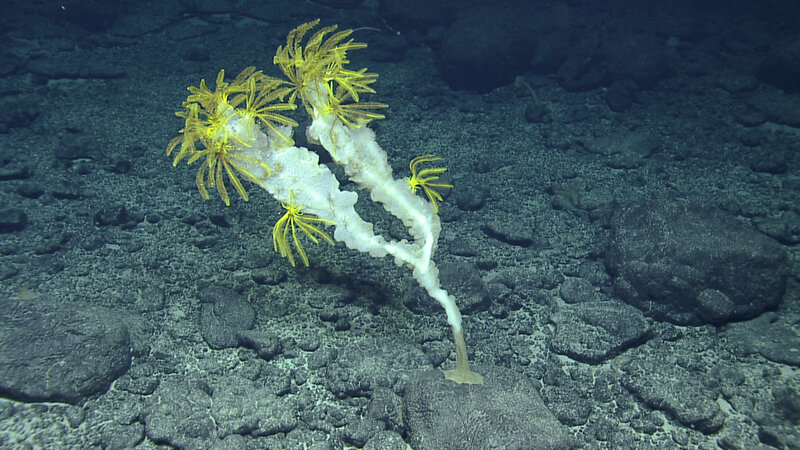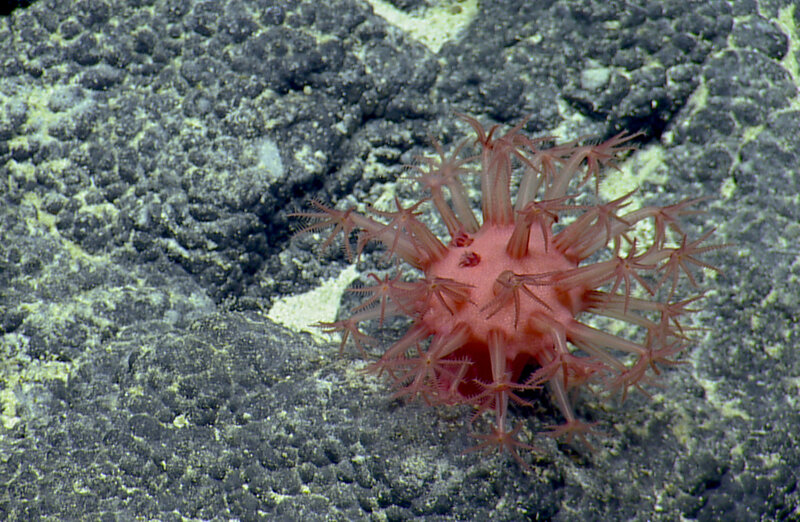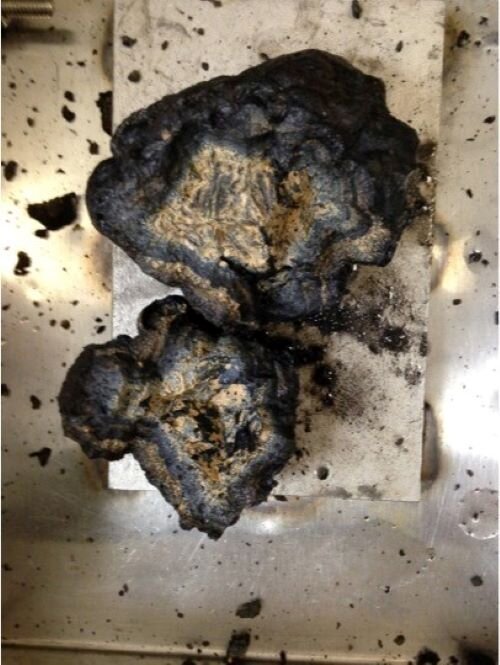
Microbial Ecosystem Services on Seamounts in the Papahānaumokuākea Marine National Monument
Past Expedition
Overview
November 14 – December 6, 2021
As part of the Luʻuaeahikiikapapakū – Ancient Volcanoes in Papahānaumokuākea Marine National Monument expedition on Exploration Vessel Nautilus, a team of researchers will examine microbial ecosystem services and microbe-mineral interactions on the seamounts of the monument to provide baseline information about the mineral resource potential of the seamounts and the animals that live on them in order to inform management and conservation of the area.
Crinoid feather stars attached to a sponge attached to an altered seafloor basalt, observed in 2018 on a seamount of the Naifeh chain within the Papahānaumokuākea Marine National Monument (PMNM) on Expedition NA101 of Exploration Vessel Nautilus. The Microbial Ecosystem Services at Seamounts project will characterize the mineral crust and microbial resources of seamount rocks of other unexplored seamounts of the PMNM. Image courtesy of the Ocean Exploration Trust/Nautilus Live, NA101. Download largest version (jpg, 825 KB).
The Lu’uaeahikiikapapakū Expedition (NA134) on the Ocean Exploration Trust’s Exploration Vessel Nautilus is a collaborative project funded by NOAA Ocean Exploration through the NOAA Ocean Exploration Cooperative Institute, with additional support from NOAA’s Office of Marine Sanctuaries, the National Oceanographic Partnership Program, and the NOAA Ocean Exploration’s Fiscal Year 2021 funding opportunity. This 21-day expedition will explore seamounts located in the “expansion” area of the Papahānaumokuākea Marine National Monument (PMNM).
PMNM is a region of cultural significance to Native Hawaiians, and management of the monument identifies and integrates traditional knowledge and management concepts with contemporary designations. A 2018 Nautilus expedition in the central extent of the PMNM revealed coral and sponge communities on seamounts supporting diverse mobile invertebrate and fish species. However, little is scientifically known of the underwater seamounts in the western extent of the PMNM in terms of benthic (seafloor) animal communities, ages of the seamounts, and the services that these ecosystems provide.
The overall objectives of this collaborative expedition are to:
- survey these seamounts, mapping those that have not been previously mapped;
- collect rock samples from as many of these seamounts as possible to determine their ages;
- document the biological communities that presently live on these seamounts, looking in particular for high-density coral and sponge communities;
- collect macro-biological specimens (e.g., animals visible to the naked eye) that are potential new species or new records of species for PMNM;
- determine microbial ecosystem services and mineral content of the rocks to examine microbe-mineral interactions in ferromanganese crusts; and
- collect water samples to support an environmental DNA (eDNA) study in the monument that began in 2018.
This scientific exploration and characterization of the marine natural monument is allowed with permit PMNM-2021-21, issued by approval of the co-trustees of the PMNM. A return Ocean Exploration Trust expedition to the region – Lu’uaeahikiikekumu – is scheduled to take place in April 2022.
A type of mushroom coral on altered basalts observed in 2018 on a seamount of the Naifeh chain within the Papahānaumokuākea Marine National Monument (PMNM) on Expedition NA101 of Exploration Vessel Nautilus. Image courtesy of the Ocean Exploration Trust/Nautilus Live, NA101. Download largest version (jpg, 425 KB).
As part of this collaborative expedition series, NOAA Ocean Exploration is supporting a team of researchers led by Dr. Beth Orcutt through its Fiscal Year 2021 funding opportunity to examine microbial ecosystem services and microbe-mineral interactions on the seamounts of the PMNM. Ferromanganese crusts found on seamounts can contain critical minerals that are used in consumer electronics, defense manufacturing, renewable energy industries, and more. As demand for these critical minerals increases, ferromanganese crusts are being considered as a potential natural resource. Yet, little is known about how the characteristics of these crusts vary from region to region within the oceans or the microorganisms that live on and within them.
Example of a highly altered 23-million-year-old seafloor basalt with a thick rind of black-colored ferromanganese crust. Image courtesy of Mike Lee from cruise AT26-09 of the Research Vessel Atlantis, Woods Hole Oceanographic Institution. Download largest version (jpg, 63 KB).
To better understand ferromanganese crusts and their associated ecosystems, the team will characterize the mineralogy and microbiology of the seamount environments. The goal of these analyses is to provide baseline information regarding the mineral resource potential as well as the parallel living communities of these seamounts that will be used to inform the ongoing management and conservation of the area.
These studies will also contribute to the mission of a new National Science Foundation-funded internal research coordination network called the Crustal Ocean Biosphere Research Accelerator (COBRA).
Join this expedition and send in your questions for explorers through the 24/7 livestream at www.NautilusLive.org
Published November 10, 2021
Education
Our Learn & Discover page provides the best of what the NOAA Ocean Exploration website has to offer to support educators in the classroom during this expedition. Each theme page includes expedition features, lessons, multimedia, career information, and associated past expeditions. Below are related top education themes for this expedition.
Meet the Exploration Team
Learn more about the team members and their contributions to this project.






